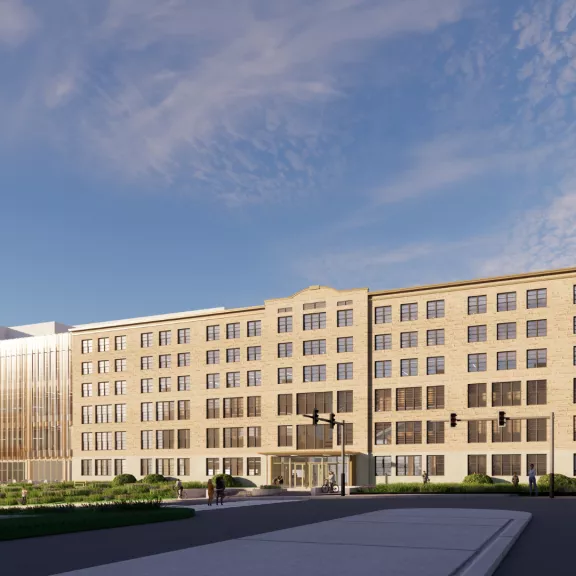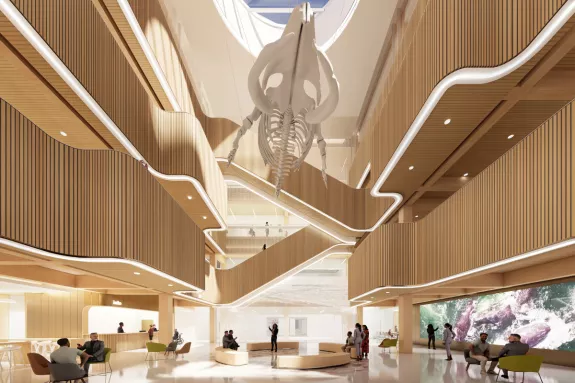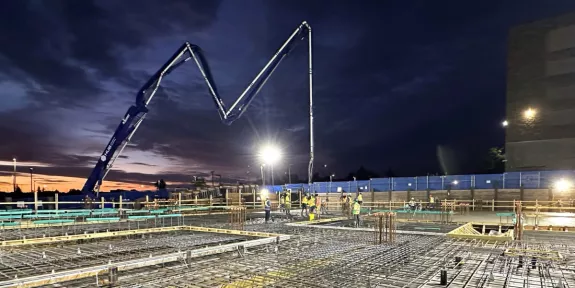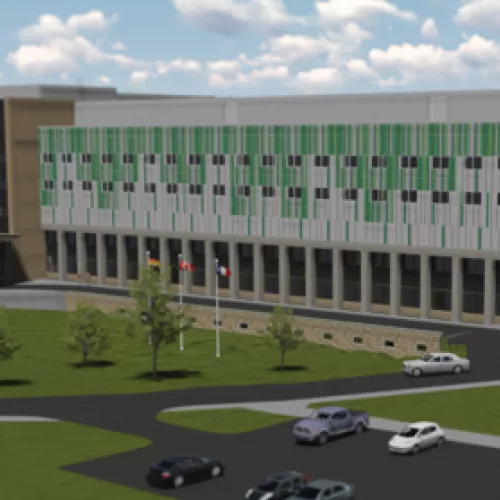
Building the Atlantic Science Entreprise Centre in Moncton
- Client
- Public Services and Procurement Canada
- Sector
- Institutional
- Delivery mode
- Construction Management
- Location
- Moncton, NB, CA
- Year built
- 2032

The Atlantic Science Enterprise Centre (ASEC) project in Moncton is a landmark initiative that reflects Pomerleau’s commitment to innovation, sustainability, and inclusive collaboration. Designed to transform a historic site into a cutting-edge scientific hub, this long-term construction project integrates advanced technologies, Indigenous partnerships, and environmental excellence.
From Historic College to Scientific Centre
The ASEC site in Moncton originally hosted the Collège Notre-Dame d’Acadie, a college and boarding school for Acadian girls that was built in 1948. Founded and run by the Sisters of Notre-Dame-du-Sacré-Coeur, the college was closed in 1965, and ultimately completely retrofitted in 1982 by the Department of Fisheries and Oceans Canada. Since then, the site has operated as the Gulf Fisheries Centre. The new building on this site will house the Atlantic Science Enterprise Centre (ASEC).
The ASEC project is a monumental construction endeavour spanning 125 months, from November 2021 to March 2032. With a total budget of approximately $400 million, this large-scale, construction process unfolds across three distinct phases. The project ensures active participation from all stakeholders, including specialists and contractors. Emphasis is placed on capturing existing conditions prior to execution and leveraging collaborative processes for efficient construction.
Smart Construction Powered by Technology
At the heart of the ASEC project are technological advancements that drive efficiency and precision. The integration of BIM (Building Information Modeling) and 3D Revit allows for comprehensive modeling and planning. Drone photography and videography, supported by the client, are used to capture and present visuals throughout the process. Additionally, a live site monitoring tool, Devisbox, provides real-time high-definition time-lapse imagery. Vibration and noise sensors installed inside existing lab buildings send alerts when critical thresholds of sound and vibration are reached, ensuring safety and precision. Smart boards and remote design planning tools further enhance collaboration and planning efficiency.
Inclusive Collaboration and Indigenous Engagement
Collaboration is key to the success of the ASEC project. A shared workspace fosters constant, on-the-ground collaboration between the client, design team, and Pomerleau as the Construction Manager. Select subcontractors are involved early in the design phase, with access to all planning tools, allowing for seamless integration and cooperation.
The project proudly integrates Indigenous participation, and the team works closely with Indigenous businesses. Weighted assessments are used to support these enterprises, leading to meaningful involvement and contribution to the project.

Unique Features and Design Innovations
Several unique aspects distinguish the ASEC project. During Phase 2, a skeletal model of a North Atlantic whale will be installed in the atrium, requiring a specialty company for installation.
Sandstone from the existing building will be conserved and reinstalled in the same order to maintain its original appearance. Mass timber is an innovative component of the project, with design assistance ensuring its effective use. Pomerleau is partnering with Nordic Structures to guarantee efficiency. Design-assist and value engineering led to significant savings on the project design.
Specialized Expertise
The ASEC project team brings significant expertise, particularly in laboratory environments, clean rooms, and logistics. Efficient construction in limited space is a key skill, with detailed formwork planning enabling precision and effectiveness.
Because of the high Indigenous component in this project, Pomerleau’s strong background in Indigenous relations is proving to be an advantage.
Environmental considerations on this project
Environmental sustainability is a cornerstone of the ASEC project. The project adheres to LEED Gold criteria, with stringent requirements for indoor air quality, erosion, sedimentation, and waste management. Pulverized concrete may be used for backfill, promoting recycling and reuse. The project includes a geothermal wellfield, heat pumps, heat recapture, dry coolers, green water usage, and efficient mechanical and electrical systems. Heat recovery from sanitary water is also being implemented to uphold sustainability goals.

Construction Challenges at the ASEC Moncton Site
The ASEC project faces several challenges, including limited site space and numerous city bylaw requirements. Security is a priority, with reliability checks and background screenings in place. Logistics are complex, especially during the transition period of Phase 1 while the existing building is occupied. Trade availability and market overheating are major challenges, with many large-scale projects in the Atlantic region impacting supply and demand.
Pomerleau’s Pride in Building a Legacy
Pomerleau is proud to lead the ASEC project, a transformative initiative that embodies our values of innovation, sustainability, and community engagement. This project is more than construction, it’s a legacy for future generations of scientists and citizens in Atlantic Canada.
The site in numbers
125 months: Total project duration from November 2021 to March 2032
Including the Enabling Works Phase of the project which spanned from November 2021 to September 2024
Phase 1 and Phase 2 construction of new facilities spans from September 2024 through March 2032.
Hourly updates: Real-time high-definition time-lapse imagery provided by Devisbox.
$61M committed towards Indigenous Participation.


